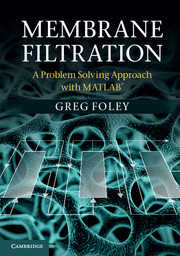Book contents
- Frontmatter
- Dedication
- Contents
- Preface
- Abbreviations
- 1 Introduction to membrane filtration of liquids
- 2 Dead-end filtration
- 3 Crossflow microfiltration
- 4 Ultrafiltration flux theories
- 5 Ultrafiltration process analysis and design at the limiting flux
- 6 Diafiltration at the limiting flux
- 7 Ultrafiltration and diafiltration with incomplete rejection
- 8 The osmotic pressure model applied to ultrafiltration and diafiltration
- 9 Reverse osmosis and nanofiltration
- 10 Membrane fouling
- Appendix Mathematical and computational background
- Index
- References
4 - Ultrafiltration flux theories
Published online by Cambridge University Press: 05 July 2013
- Frontmatter
- Dedication
- Contents
- Preface
- Abbreviations
- 1 Introduction to membrane filtration of liquids
- 2 Dead-end filtration
- 3 Crossflow microfiltration
- 4 Ultrafiltration flux theories
- 5 Ultrafiltration process analysis and design at the limiting flux
- 6 Diafiltration at the limiting flux
- 7 Ultrafiltration and diafiltration with incomplete rejection
- 8 The osmotic pressure model applied to ultrafiltration and diafiltration
- 9 Reverse osmosis and nanofiltration
- 10 Membrane fouling
- Appendix Mathematical and computational background
- Index
- References
Summary
Introduction
Modelling, analysis and design of chemical engineering systems generally proceed on two fronts. First, the mass and/or energy balances for the system are formulated. On their own, these balances are rarely sufficient to derive equations with which practical calculations can be performed. This is because the balances typically contain some unknown term, or terms, which quantify the rate at which some key process is occurring. Quantifying this rate is the second step in the analysis. A classic example would be the kinetic term in a model of a batch reactor. Alternatively, an equilibrium relation might provide a crucial relationship between compositions in the liquid and vapour streams of a distillation process, thus providing the missing information required to solve the complete model equations. In this chapter the underlying rate equations for UF design and analysis are established. A number of different equations, of varying complexity, are presented and their main features outlined. The rate equation in this case is simply an equation that relates the permeate flux to measurable process variables, notably the crossflow velocity, the solute concentration and the trans-membrane pressure. In subsequent chapters, each of the rate equations is combined with appropriate mass balances for batch and continuous ultrafiltration and diafiltration systems. As will be seen, the combination of the rate equation and the mass balances leads to a variety of computational challenges. However, with modern software tools, these are easily overcome.
In addition to reviewing the basic theory of UF, this chapter provides the reader with a very brief overview of methods for predicting mass transfer coefficients, viscosities and osmotic pressures for a range of solutions relevant to UF practice. This is by no means an exhaustive review but is intended to give the reader a sense of the issues involved in actually trying to apply the various UF theories. The data provided should also prove useful for performing practice calculations.
- Type
- Chapter
- Information
- Membrane FiltrationA Problem Solving Approach with MATLAB, pp. 88 - 119Publisher: Cambridge University PressPrint publication year: 2013



